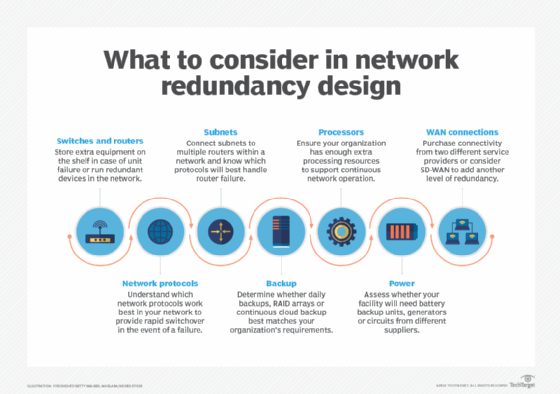As our reliance on technology continues to grow, the importance of a reliable and efficient network cannot be overstated. Network downtime can have disastrous effects on businesses and organizations, resulting in lost productivity, revenue, and customer trust. In order to mitigate the risks of network failure, building redundancy into a network has become a crucial aspect of network design.
Redundancy refers to the practice of duplicating critical components of a network to ensure that if one component fails, there is a backup in place to take over. Redundancy can be built into various aspects of a network, including hardware, software, and connectivity. In this article, we will explore the benefits of building redundancy into a network and how it can help organizations maintain their competitive edge in an increasingly connected world.

What is Redundancy in a Network?
Redundancy in a network is the creation of a backup system that can take over if the primary system fails. It is a system of checks and balances that helps to maintain the reliability of a network. Redundancy can be implemented in a variety of ways, including redundant hardware, redundant software, and redundant network connections.
Benefits of Building Redundancy into a Network
Improved Reliability
Redundancy in a network helps to ensure that the network is reliable and can continue to provide services even if one component fails. By having a redundant system, the network is less likely to suffer from outages or slowdowns due to a single component failure. Redundancy also helps to prevent data loss and ensures that the network can continue to operate even if one component fails.
Increased Uptime
Redundancy in a network helps to ensure that the network is always up and running. If one component fails, the redundant system can take over and provide services without any disruption. This helps to ensure that the network remains available and is less likely to suffer from outages or downtime. As a result, businesses can rely on their networks to provide reliable services.
Reduced Maintenance Costs
Redundancy in a network can help to reduce maintenance costs. By having a redundant system, businesses can reduce the amount of time and money spent on maintaining the network. It also helps to reduce the amount of time needed to replace failed components, as the redundant system can take over while the replacement is being made.
Improved Security
Redundancy in a network can help to improve security. By having a redundant system, businesses can protect their networks from attacks and other malicious activity. Redundancy also helps to reduce the risk of data loss, as the redundant system can take over if one component fails.
Increased Scalability
Redundancy in a network can help to increase the scalability of the network. By having a redundant system, businesses can easily add or remove components from the network without disruption. This helps to ensure that the network can easily adapt to changes in the environment or user demands.
Reduced Risk
Redundancy in a network helps to reduce the risk of downtime or data loss. By having a redundant system, businesses can ensure that their networks are always available and reliable. This helps to reduce the risk of costly outages and data loss, which can have a significant impact on a business.
Frequently Asked Questions
Redundancy in networks is a system of backup components and protocols which allow for the continuous operation of a service or system, even in the event of a component failure. Redundancy is important for any network, as it ensures that critical operations and services remain intact, even if a single component fails.
What are the advantages of building redundancy into a network?
Building redundancy into a network has a number of advantages. First, it ensures that critical services and operations remain unaffected by component failure. This means that businesses can continue to operate without any interruption, even if a single component in the network fails. Additionally, redundant networks tend to be more reliable and resilient, as any component failure or interruptions can be quickly addressed with minimal disruption. Finally, redundant networks are more secure, as they can be configured to automatically switch to a backup system in the event of a security breach.
What types of components can be used to build redundancy into a network?
When building redundancy into a network, there are several components that can be used. These include routers, switches, servers, and storage systems. Additionally, redundant networks often include software components such as virtualization, clustering, and load balancing. Redundancy also requires that these components be connected properly in order to maintain the network’s availability and reliability.
What is the importance of redundancy when it comes to network security?
Redundancy is essential for network security. Redundant networks are configured to automatically switch to a backup system in the event of a security breach, which ensures that critical operations and services remain unaffected. Additionally, redundant networks tend to have better security protocols in place, as they can detect any suspicious activity and respond quickly with minimal disruption.
How can redundancy help reduce downtime and improve efficiency?
Redundancy can help reduce downtime and improve efficiency by providing a backup system which can take over should a component in the network fail. This allows businesses to continue to operate without any interruption, as the redundant system can take over and maintain operations until the failed component is repaired. Additionally, redundant networks are often more reliable and resilient, as any component failure or interruptions can be quickly addressed with minimal disruption.
What are the costs associated with building redundancy into a network?
The cost of building redundancy into a network depends on the number of components and the complexity of the network. However, the cost of redundancy is often outweighed by the benefits it provides. Redundancy helps to ensure that critical operations and services remain unaffected by component failure, and it can reduce the amount of downtime and improve efficiency. Additionally, redundant networks are often more secure, as they can be configured to automatically switch to a backup system in the event of a security breach.
In conclusion, building redundancy into a network is an essential requirement for any organization that values smooth operations and minimal downtime. By having multiple paths and backups, redundancy ensures that even in the event of hardware failure or network congestion, the network will continue to function seamlessly. This not only enhances productivity but also helps to minimize the risk of data loss, which can have severe financial and reputational implications for any business.
Moreover, redundancy also provides organizations with the flexibility to scale their networks to keep up with increasing demand. As an organization grows, network congestion can become a significant challenge, leading to downtime and loss of productivity. However, with redundancy, organizations can easily add new devices and paths to their networks without interrupting operations. Overall, the benefits of building redundancy into a network are clear, and any organization that values efficiency, productivity, and data security should prioritize investing in redundancy.



